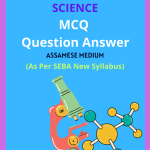Class 7 Science MCQ Chapter 8 Winds, Storms and Cyclones Solutions in English Medium, Class 7 Science Multiple Choice Question Answer in English to each chapter is provided in the list so that you can easily browse throughout different chapters Class 7 Science MCQ Chapter 8 Winds, Storms and Cyclones Notes and select need one.
Class 7 Science MCQ Chapter 8 Winds, Storms and Cyclones
Also, you can read the SCERT book online in these sections Class 7 Science Objective Type Solutions by Expert Teachers as per SCERT (CBSE) Book guidelines. These solutions are part of SCERT All Subject Solutions. Here we have given Assam Class 7 Science MCQs Solutions in English for All Subject, You can practice these here.
Winds, Storms and Cyclones
Chapter – 8
| MCQ |
1. Wind is not caused due to:
(a) Uneven heating between equator and poles.
(b) Air pressure.
(c) Due to uneven heating of land and water.
(d) Difference in humidity.
Ans: (d) Difference in humidity.
2. Increased wind speed:
(a) Increases air pressure.
(b) Does not affect air pressure humidity.
(c) Reduces air pressure.
(d) Lowers humidity.
Ans: (c) Reduces air pressure.
3. The centre of cyclones is called:
(a) Eye.
(b) Water spouts.
(c) Storm-surge.
(d) Head.
Ans: (a) Eye.
4. Tropical cyclones that originate in the China sea are:
(a) Hurricanes.
(b) Typhoons.
(c) Tornadoes.
(d) Cyclones.
Ans: (b) Typhoons.
5. Which of the following plays a major role in the formation of a thunderstorm?
(a) Conduction.
(b) Convection.
(c) Radiation.
(d) All of the above.
Ans: (b) Convection.
6. The winds from oceans carry water and bring rain are called:
(a) Cyclone.
(b) Typhoon.
(c) Monsoon.
(d) None of the above.
Ans: (c) Monsoon.
7. Which of the following places is likely to get affected by a cyclone?
(a) Delhi.
(b) Jaipur.
(c) Amritsar.
(d) Puri.
Ans: (d) Puri.
8. Formation of a thunderstorm requires:
(a) Moisture.
(b) Rapidly rising warm air.
(c) Sea breeze.
(d) All of the above.
Ans: (d) All of the above.
9. Which of the following contributes to the development of cyclones?
(a) Wind speed.
(b) Temperature.
(c) Humidity.
(d) All of the above.
Ans: (d) All of the above.
10. Precautions to be observed during a thunderstorm when you are inside:
(a) Do not sit near the open window.
(b) Do not operate any electrical appliance.
(c) Do not watch T.V.
(d) All of the above.
Ans: (d) All of the above.
11. Which one of the following places is unlikely to be affected by a cyclone?
(a) Chennai.
(b) Mangaluru (Mangalore).
(c) Amritsar.
(d) Puri.
Ans: (c) Amritsar.
12. A system of wind which moves away from the sea towards the land in the latitudes of 5° to 30° is called:
(a) Monsoon.
(b) Rain.
(c) Wind.
(d) None of the above.
Ans: (a) Monsoon.
13. In which year was Orissa hit by a cyclone?
(a) 1999.
(b) 2000.
(c) 2001.
(d) 2004.
Ans: (a) 1999.
14. Which of the following places is most likely to be affected by a cyclone?
(a) Delhi.
(b) Puri.
(c) Pune.
(d) Porbandar.
Ans: (b) Puri.
15. What happens to air when it is heated?
(a) It contracts.
(b) It rises and expands.
(c) It sinks.
(d) It remains the same.
Ans: (b) It rises and expands.

Hi! my Name is Parimal Roy. I have completed my Bachelor’s degree in Philosophy (B.A.) from Silapathar General College. Currently, I am working as an HR Manager at Dev Library. It is a website that provides study materials for students from Class 3 to 12, including SCERT and NCERT notes. It also offers resources for BA, B.Com, B.Sc, and Computer Science, along with postgraduate notes. Besides study materials, the website has novels, eBooks, health and finance articles, biographies, quotes, and more.



